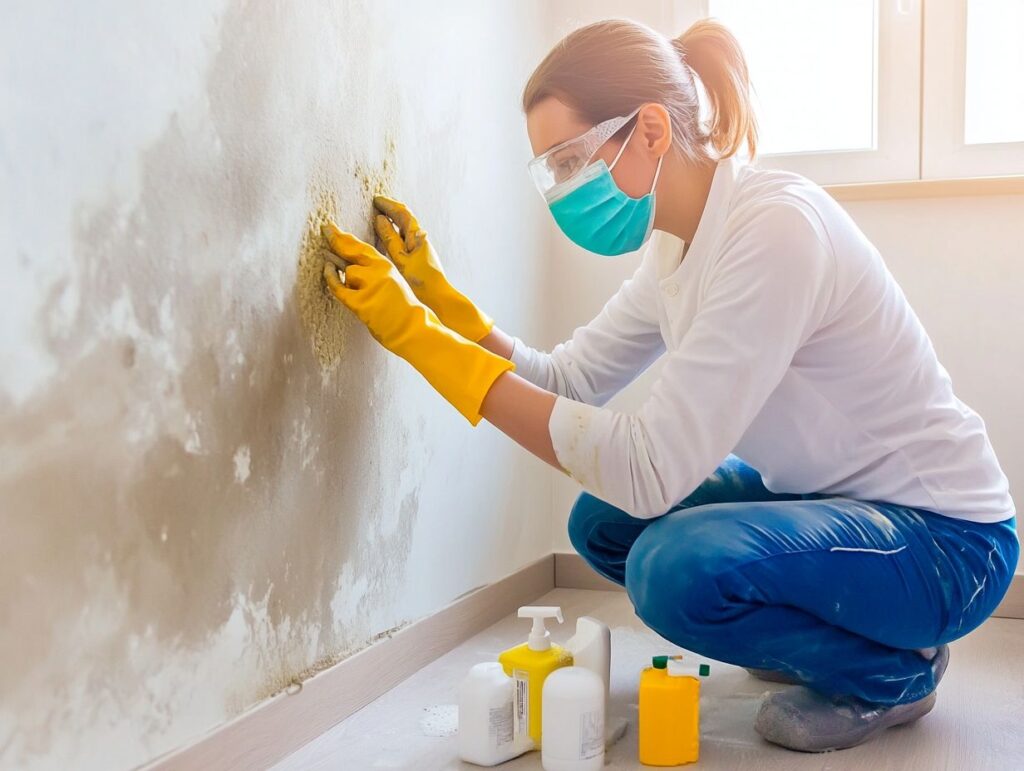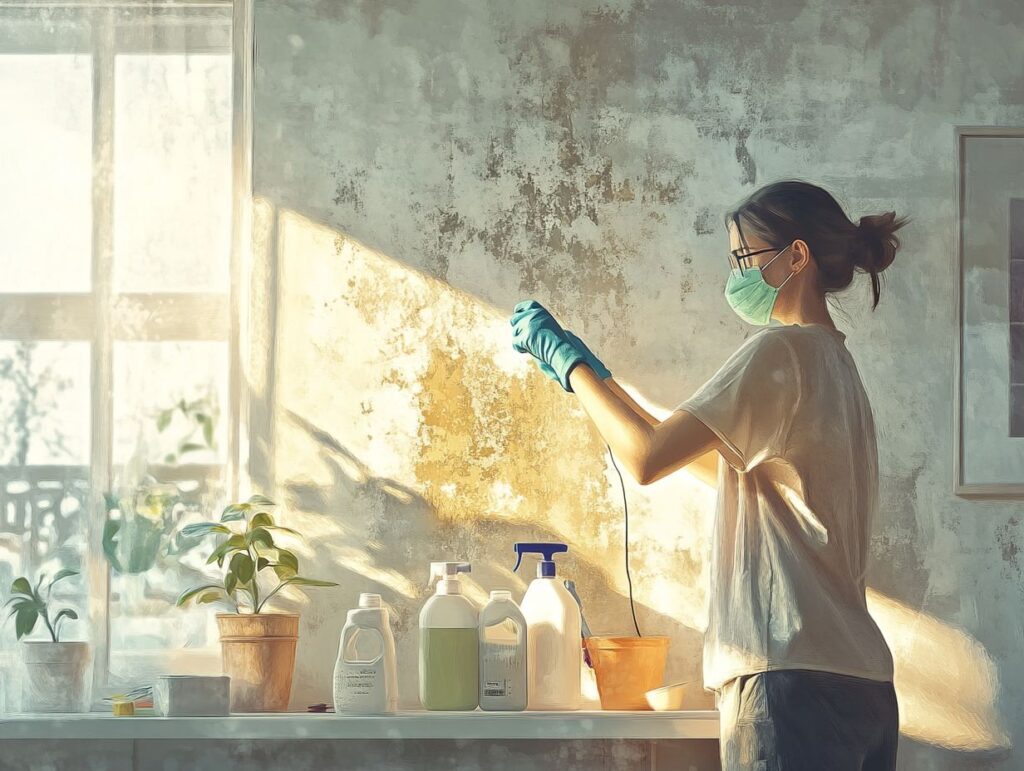Mould and mildew may seem like minor nuisances, but they can pose significant problems in our homes and health. Understanding their differences, causes, and signs of growth is essential for maintaining a safe living environment.
This article explores the potential health risks of mould and mildew, offers effective removal techniques, and shares proactive prevention tips. Equip yourself with the knowledge to tackle these persistent issues and protect your home and well-being.

Understanding Mould and Mildew
Understanding mould and mildew is key to keeping your home environment healthy. These two types of fungi love dampness and high humidity, often setting up camp in basements, bathrooms, and kitchens. They reproduce through spores, which can interfere with air quality and lead to health issues like allergies and asthma.
That’s why you need to spot the signs of their growth on different surfaces. By doing this, you can take proactive cleaning and preventative steps to protect your home and family.
Differences and Similarities
Mould and mildew might look similar, but when you delve into their characteristics and health risks, they are quite different. Mould usually has that fuzzy texture and loves to burrow deep into porous materials, whereas mildew is like a powdery film that sits on surfaces, making it easy to clean.
They also prefer different surfaces. Mould flourishes in damp, organic materials like wood and plasterboard, whereas mildew often appears on bathroom tiles and fabrics, especially in humid spots.
In terms of health, mould can lead to serious issues, such as respiratory problems and allergic reactions, particularly for sensitive people. Conversely, Mildew is generally less of a threat unless it escalates into something more serious.
By understanding these differences, you can take the proper steps to prevent mould and mildew from growing, helping to protect your home and your health.
Causes of Mould and Mildew Growth
The causes of mould and mildew growth usually come down to environmental factors, especially when there is too much humidity and dampness in your home.
These pesky fungi love to hang out in places with poor ventilation and high moisture levels, possibly due to condensation, water damage, or leaks in your building materials.
Common Triggers and Contributing Factors
High humidity levels, poor ventilation, and existing water damage are common triggers for mould and mildew growth. These conditions create a perfect playground for these pesky fungi, especially in areas like laundries, kitchens, and bathrooms.
Seasonal changes can worsen these issues, particularly during warmer months when humidity levels spike. It’s easy to overlook routine maintenance tasks, like cleaning gutters or fixing leaky pipes, which can lead to moisture build-up.
If your property has poor insulation, you might experience temperature swings encouraging condensation. To tackle these problems, consider installing dehumidifiers in high-risk spots and ensuring your extractor fans work properly.
Regularly checking and maintaining your plumbing and keeping your living spaces well-ventilated can help minimise the chances of mould and mildew growing at home.

Signs of Mould and Mildew in Your Home
Recognising the signs of mould and mildew in your home is extremely important for keeping your indoor environment healthy. You might spot visible growth on walls, ceilings, and carpets. This often comes with a musty smell or discolouration, indicating moisture issues.
Identifying Visible and Hidden Growth
To spot visible and hidden mould and mildew in your home, you’ll need to give it a good once-over, paying special attention to common moisture hotspots like the kitchen, bathrooms, and cellar. Look for discoloured patches, musty smells, and any signs of spores lurking on surfaces.
For a thorough evaluation, it’s wise to use specialised inspection tools like moisture meters and thermal imaging cameras. These handy gadgets can reveal damp spots behind walls or under flooring that your eyes might miss.
You might also want to check for condensation on windows and assess your ventilation systems—these techniques can enhance your detection skills. Catching mould and mildew early is crucial to avoid serious damage and health problems, so making regular inspections part of your routine is always a good idea.
By staying alert and informed, you can effectively tackle mould and mildew before they become a bigger issue.
Health Risks Associated with Mould and Mildew
Pay attention to the health risks of mould and mildew, especially if you have allergies or asthma. Exposure to these fungi can cause respiratory problems and other complications since they release spores and toxic substances into the air.
This can seriously aggravate any existing health conditions you may have.
Potential Health Effects and Complications
Potential health effects and complications from mould and mildew exposure can range from minor allergic reactions to major respiratory problems and other chronic conditions. When you come into contact with affected areas, you might sneeze, cough, or deal with skin irritation.
Studies show that about 21% of the population in the UK deals with allergic reactions from mould exposure, and children or those with pre-existing respiratory issues are especially at risk. Chronic exposure isn’t something to take lightly, either; it can lead to more serious issues like asthma attacks and other pulmonary problems, especially for those who are already sensitive.
For example, the Centres for Disease Control and Prevention (CDC) reports that mould exposure can make asthma symptoms worse, with some people experiencing up to a 30% increase in asthma-related emergencies. Long-term exposure to certain types of mould, like Stachybotrys chartarum (black mould), can even lead to neurological symptoms because of toxic mycotoxins.
This highlights the importance of addressing mould growth in your home or workplace before it becomes a bigger problem.
How to Get Rid of Mould and Mildew
To effectively remove mould and mildew, you need a solid cleaning strategy that uses the right removal techniques and cleaning solutions. You can use everyday household items like vinegar and bicarbonate of soda, or if the situation calls for it, stronger disinfectants like bleach to wipe out that pesky growth from surfaces.
Effective Cleaning and Removal Techniques
To clean and remove mould and mildew, scrub the affected surfaces with the right cleaning solutions and tools. A spray bottle filled with vinegar or a paste made from bicarbonate of soda can work wonders on surface stains and help stop further growth.
It’s important to figure out what kind of surface you’re dealing with because different materials need different approaches. For example, if you’re working with non-porous surfaces like tiles, you can clean them nicely with water and washing-up liquid. Just make sure to dry them thoroughly afterwards to keep moisture at bay.
On the other hand, if you’re tackling porous materials like wood or plasterboard, you might need some specialised mould removers that can penetrate deeper. Plus, careful drying is essential to avoid warping or damage.
Whether you go the DIY route or call in the professionals, focusing on thorough cleaning and drying techniques is key to keeping mould from returning for good.
Preventing Mould and Mildew in Your Home
You’ll want to adopt some proactive maintenance tips and strategies to prevent mould and mildew from taking over your home. Start by ensuring proper ventilation in humid areas, and consider using a dehumidifier to help control moisture levels.
Regularly inspecting for leaks or any signs of water damage is also a good idea.
Proactive Measures and Maintenance Tips
Implementing proactive measures and maintenance tips can significantly reduce your home’s risk of mould and mildew. Regularly using air purifiers and cleaning solutions can also help keep your indoor air quality in check and prevent moisture build-up.
In addition, consider applying mould-resistant paint. It protects against moisture and makes your home less inviting for mould spores.
Remember to conduct routine inspections in areas prone to dampness, such as bathrooms, basements, and kitchens. Catching potential issues early can save you a lot of hassle. Check for leaks in your plumbing and ensure proper ventilation to reduce the risk further.
Combining these strategies can create a healthier living space while protecting your home maintenance investment.